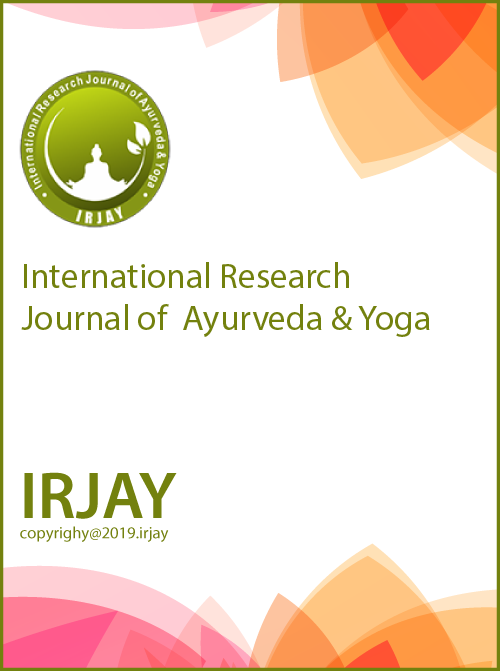Majjagni: A Classical Ayurvedic Appraisal of Marrow Metabolism and its Pathogenetic Role in Majja Pradoshaja Vikara
Keywords:
Adrenal Hormones, Majja Pradoshaja Vikara, Majja, Majjagni, Pituitary HormonesAbstract
Introduction: In Ayurvedic physiology, Majjagni (the tissue-specific metabolic fire associated with Majja Dhatu) plays a critical role in the biotransformation, nourishment, and maintenance of bone marrow and neural tissues. Despite its critical significance, the precise physiological and pathological dimensions of Majjagni, particularly in the context of Majja Pradoshaja Vikara, remain under-defined within classical discourse. Materials and Methods: A comprehensive review of classical Ayurvedic treatises and standard reference texts was undertaken to delineate the Ayurvedic understanding of Majjagni. Descriptive analysis and thematic synthesis were employed to interpret its role in tissue metabolism and disease causation. Discussion: The review highlights Majjagni as a key determinant in sustaining Majja Dhatu homeostasis, supporting structural integrity, immunity, and neural function. Aberrations in Majjagni lead to the onset of Majja Pradoshaja Vikara, characterized by either pathological accumulation or depletion of marrow tissue, resulting in systemic and neuromuscular dysfunction. Classical Ayurvedic text also attributes a stimulatory role to Vata, which aligns conceptually with modern neuroendocrine regulation. Interpretive correlations with pituitary-adrenal hormones and hematopoietic modulators underscore Ayurveda’s sophisticated recognition of the neuroendocrine-immune dynamics governing marrow metabolism. Conclusion: However, the lack of explicit diagnostic criteria for Majjagni-mediated pathologies remains a key limitation, warranting further research to refine its clinical assessment and enhance its relevance within Ayurvedic diagnostics and therapeutic frameworks.
Downloads
References
1. Malviya A, Shakya J, Pandey PK, Palsedkar R. Study of Agni in different metabolic disorders- a review. World J Pharm Sci Res. 2023;2(2):1-10.
2. Trikamji Y, editor. Charaka samhita of agnivesha, chikitsa sthana; Grahanidosha chikitsa adhyaya. (Chakrapani tika). Ch. 15., Ver. 38. Varanasi: Chaukhambha Orientalia; 2015. p. 516.
3. Patel V, Sasmal G, Kumar A. The concept of majja dhatu. World J Pharm Res. 2020;9(2):335-40. doi: 10.20959/wjpr20202-16614 4. Trikamji Y, editor. Sushruta samhita of sushruta, sharira sthana;
Garbhavyakarana sharira adhyaya. Ch. 4., Ver. 12-13. Varanasi: Chaukhambha Orientalia; 2015. p. 356.
5. Shivprasad Sharma, editor. Ashtanga samgraha of vriddha vagbhata, Sharira sthana; Angavibhaga adhyaya. Ch. 5., Ver. 33. Varanasi: Chowkhamba Sanskrit Series Office; 2012. p. 302-3.
6. Trikamji Y, editor. Charaka samhita of agnivesha, chikitsa sthana; Grahanidosha chikitsa adhyaya. Ch. 15., Ver. 16. Varanasi: Chaukhambha Orientalia; 2015. p. 514.
7. Trikamji Y, editor. Sushruta samhita of sushruta, sutra sthana; Shonitavarnaniya adhyaya. Ch. 14., Ver. 10. Varanasi: Chaukhambha Orientalia; 2015. p. 60.
8. Trikamji Y, editor. Charaka samhita of agnivesha, chikitsa sthana; Grahanidosha chikitsa adhyaya. (Chakrapani tika). Ch. 15. Ver. 13. Varanasi: Chaukhambha Orientalia; 2015. p. 513.
9. Trikamji Y, editor. Charaka samhita of agnivesha, chikitsa sthana; Grahanidosha chikitsa adhyaya. (Chakrapani Tika). Ch. 15., Ver. 14. Varanasi: Chaukhambha Orientalia; 2015. p. 514.
10. Niranjandev ayurvedalankara. Prakruta agni vigyana. Prakruta dhatvagni vimarsha, majjagni adhayaya. Sec. 4. Lucknow: Ayurvedic Evam Tibbi Academy; 1974. p. 217.
11. Trikamji Y, editor. Charaka samhita of agnivesha, chikitsa sthana; Grahanidosha chikitsa adhyaya. (Chakrapani Tika). Ch. 15., Ver. 15. Varanasi: Chaukhambha Orientalia; 2015. p. 514.
12. Trikamji Y, editor. Sushruta samhita of sushruta, sutra sthana; Dosha-dhatu-mala-kshayavriddhi viganiya adhyaya. Ch. 15., Ver. 5.
42 Gill, et al.: Majjagni and its Pathogenetic Role in Majja Pradoshaja Vikara 2025; 8(5):39-44
Varanasi: Chaukhambha Orientalia; 2015. p. 67-8.
13. Trikamji Y, editor. Charaka samhita of agnivesha, vimana sthana; Rogabhisagjitiya adhyaya. Ch. 8., Ver. 108. Varanasi: Chaukhambha Orientalia; 2015. p. 278.
14. Paradakara HS, Editor. Ashtanga hridaya of vagbhata, sutra sthana; Doshahiviganiya adhyaya. Ch. 11., Ver. 34. Varanasi: Chaukhambha Orientalia; 2019. p. 188.
15. Shastri H. Dehadhatvagni vigyanam. Appendix 1. Delhi: Motilal Banarasidas Publications; 1977. p. 198-9.
16. Shastri H. Dehadhatvagni vigyanam. Ch. 11. Delhi: Motilal Banarasidas Publications; 1977. p. 100-2.


